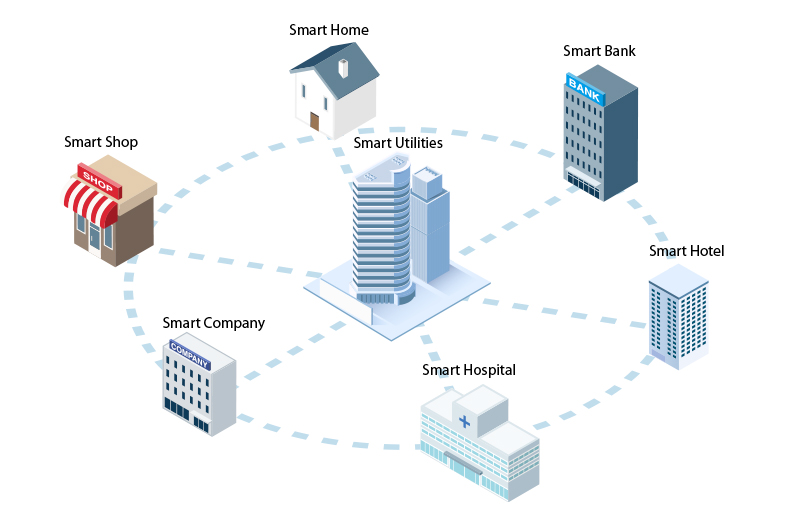Cat6 Ethernet Cable in Smart Buildings' Network
We may live in a wireless world, but we still require wiring. We may require less wire than in the past, but devices demanding wireless networks necessitate high-performance, high-quality wired infrastructure with cables capable of handling increased traffic and continuously evolving technology and standards. In this blog post, we will explore the role of cat6 ethernet cable in enhancing smart buildings' networks and how it can contribute to creating a seamless and efficient environment.
Smart Buildings Network Definition
A smart building network refers to the interconnected system of devices, sensors, and infrastructure within a building that enables the automation, control, and optimization of various building functions. These functions can include lighting, HVAC (heating, ventilation, and air conditioning), security systems, energy management, occupancy monitoring, and more. The network in a smart building facilitates the exchange of data and communication between different devices and systems, allowing them to work together intelligently and efficiently. It typically involves using Internet of Things (IoT) technologies, where devices and sensors are connected to a central management system or cloud platform.
By leveraging data and connectivity, a smart building network can enable advanced features and capabilities. For example, it can enable energy-saving measures by automatically adjusting lighting and HVAC based on occupancy and ambient conditions. It can enhance security by integrating surveillance cameras, access control systems, and alarms. It can also provide real-time monitoring and analytics to optimize building operations and improve occupant comfort.

Benefits of Smart Buildings
The key motivators for investing in smart building technology may be divided into three categories: economic, social, and environmental.
-
Reduced operating expenses by using less electricity, increased worker productivity, lower maintenance costs, and greater building marketability are all economic benefits.
-
Employees are the focus of social considerations, such as increased lighting for occupant health and well-being, or improved staff safety and security through integrated security systems and safer power supply.
-
Many businesses have environmental goals, and smart building technology may minimize energy use and a facility's carbon footprint.

Enhancing Smart Buildings' Networks
-
Faster Data Transfer Speeds:
Cat6 ethernet cable supports data transfer speeds of up to 10 Gigabits per second (Gbps) over a maximum distance of 55 meters. This high-speed transmission allows smart buildings to handle large amounts of data generated by connected devices, sensors, and applications with minimal latency, ensuring uninterrupted connectivity.
-
Enhanced Network Reliability:
With its improved insulation and reduced crosstalk, the cat6 ethernet cable offers enhanced network reliability. It minimizes signal interference from nearby electrical systems or other cables, leading to better network performance and reduced data loss. This reliability is crucial in smart buildings, where a stable network is essential for various IoT devices to communicate seamlessly. Think about the high-tech systems found in commercial buildings today, such as digital signage, interactive video walls featuring 4K content, high-definition professional projection systems, or cloud solutions – none would be possible without a robust wired infrastructure that can ensure uptime with no delay or interference.
-
Future-Proof Solution:
Implementing cat6 network cable in smart buildings ensures a future-proof network infrastructure. As technology evolves, the demand for higher data transfer speeds and increased bandwidth will continue to grow. Cat6 cable, with its superior performance capabilities, can support future network upgrades and advancements, eliminating the need for frequent cable replacements.
-
Compatibility and Cost-Effectiveness:
Cat6 cable is backward compatible with cat5 and cat5e cables, allowing for easy integration with existing network infrastructure. This compatibility ensures a smooth transition while maximizing the benefits of it in smart buildings. Additionally, cat6 ethernet cable offers a cost-effective solution due to its longevity, minimizing maintenance and replacement costs in the long run.

Conclusion
In the realm of smart buildings, a reliable and efficient network infrastructure is essential for seamless automation and connectivity. Cat6 ethernet cable, with its high data transfer speeds, enhanced network reliability, future-proof capabilities, compatibility, and cost-effectiveness, plays a vital role in maximizing the potential of smart buildings. By integrating cat6 network cable into the network infrastructure, smart buildings can stay connected, secure, and prepared for future technological advancements. To ensure that your network is capable of handling what’s to come, you’ll need a high-performance, Category 6 cabling system. Invest in cat6 ethernet cable, and unlock the true potential of your smart building.
You might be interested in
Email Address

-
PoE vs PoE+ vs PoE++ Switch: How to Choose?
Mar 16, 2023














